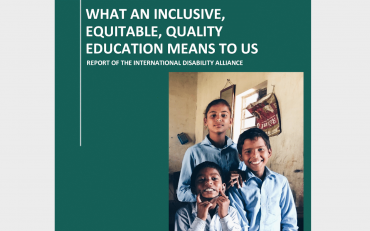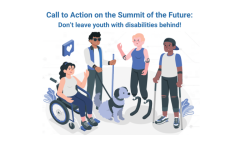“Building a truly inclusive education system is the only way to achieve SDG 4 for all children”: International Disability Alliance
June 25, Geneva
The International Disability Alliance (IDA) – a representative voice of one billion people with disabilities around the world, has released its first global report on Inclusive Education. Titled ‘What an inclusive, equitable, quality education means to us – Report of the International Disability Alliance’, it is the culmination of a two-year process of building a consensus and a cross-disability perspective from the disability rights movement on how the Sustainable Development Goal 4 on education can be achieved in line with the UN Convention on the Rights of Persons with Disabilities (UNCRPD).
Quicklinks:
The IDA Global Report aims to inform education sector stakeholders on the priorities agreed by the disability rights movement, and to equip disability activists and their allies with essential messages and recommendations to unify and strengthen advocacy towards effective and accelerated reforms of the education sector.
“The IDA report comes at a very opportune time when UNESCO has released its Global Education Monitoring (GEM) Report on inclusive education just this week. We are very happy to note that the core messages of both reports are aligned and put learner diversity at the heart of inclusive education,” said Ana Lucia Arellano, Chair of IDA.
Echoing this thought, Dr. Ruth Warick, President of the International Federation of Hard of Hearing People and member of the IDA Task Team on Inclusive Education said, “In the report, we have emphasised the need to look at inclusive education as the basis for educational transformation and not as an add-on meant only for learners with disabilities.” This principle is reflected in the UNESCO GEM Report where it states that even though inclusive education is commonly associated with needs of people with disabilities, inclusion is for all. The same mechanisms that exclude learners with disabilities also exclude other marginalised groups on account of gender, age, location, poverty, ethnicity, indigeneity, language, religion, migration or displacement status, among others.
The IDA report lays down the minimum conditions required for inclusion of all children and youths – including children and youths with disabilities in education. It puts forward measures required to build an inclusive education system geared towards providing quality education to all children and youths equitably. It also provides recommendations to governments and civil society that IDA deems essential and urgentfor the implementation of inclusive education for all learners, including children and youth with disabilities.
“Reading the IDA global report on inclusive education in conjunction with the UNESCO GEM Report will reveal how the consensus position we have built elaborates and even strengthens some of the recommendations of the GEM Report,” said Diane Richler of Inclusion International, another member of the IDA Task Team
Both reports call for investing in teacher training (including teacher diversity); collection of reliable data; application of universal design, including in curricula; engaging with community, families and civil society; targeted financing including for early intervention; among others.
This report calls for an inclusive education system where all learners with and without disabilities learn together with their peers in schools and classes in their community schools, receiving the support they need in inclusive facilities. "We are glad to see there is a growing consensus on moving away from special education models to truly inclusive schools," said Dr. Joseph Murray, President of the World Federation of the Deaf and member of the Task Team, adding, "Inclusive bilingual sign language schools are also part of this inclusive education system.”
The process to reach a cross-disability consensus position involved three technical workshops and exchanges with consultants, education sector stakeholders, inclusive education allies, global, regional and national level organizations of persons with disabilities (OPDs).
In recalling the two-year long process, Dr. Praveena Sukhraj-Ely, representative of the World Blind Union to the Task Team said, “While we were conscious of the urgency to come out with a stance that was our unambiguous collective position on inclusive education, we also had to understand the diverse perspectives and unique requirements of the needs of various learners with disabilities. We recognised that nothing less than the future of millions of learners with disabilities and diversity were at stake, but we are happy that we now have a basis on which we can build the next steps”
The Covid-19 pandemic has revealed and accentuated inequalities between learners, but has also drawn attention to the need and possibility of doing differently. As part of the next steps, IDA plans to further develop, expand and disseminate the content of the report in ways that reflect even more the wider diversity of the disability rights movement. Additionally, IDA will focus on efforts to disseminate, explain, train and advocate all concerned stakeholders on the key messages towards inclusive, quality, equitable education for all learners.
This report is the result of IDA’s Inclusive Education Flagship initiative (funded by Department for International Development, UK). Representatives of four IDA members formed the technical task team to guide the initiative and its framing of inclusive and equitable quality education. The four members are Inclusion International (II), the International Federation of Hard of Hearing People (IFHOH), the World Blind Union (WBU) and the World Federation of the Deaf (WFD).
For more details, please e-mail us at info [at] ida-secretariat.org
Social Media Toolkit
- Infographic: IDA Inclusive Education Report (narrative here)
About IDA
IDA was established in 1999 and is a network of global (8) and regional (6) organisations of persons with disabilities. IDA’s unique composition as a network of the foremost international OPDs allows it to act as the most authoritative and representative voice of persons with disabilities in the United Nations (UN) system, representing approximately one billion persons with disabilities worldwide. IDA promotes the full and effective implementation of the UNCRPD worldwide through the active and coordinated involvement of representative organizations of persons with disabilities (OPDs) at the national, regional and international levels. IDA supports OPDs in engaging with UN human rights and development processes in Geneva and New York. More details here.

